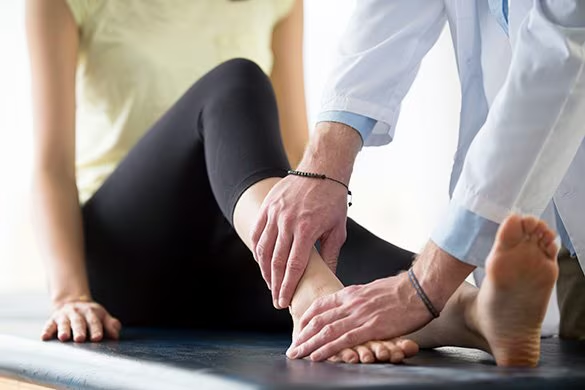Ankle pain can significantly affect your daily activities, from walking to simply standing. Understanding the sources of this discomfort is the first step toward managing it and regaining movement. Here is some information on common causes, exercises for mobility, and pain management options:
What Commonly Causes Ankle Pain?
Ankle pain can stem from various sources, making it necessary to understand what might be causing your specific discomfort. Identifying the root cause is the first step toward finding effective relief and preventing future issues. Some of the most common reasons people experience ankle pain are:
- Sprains: These are very common and occur when the ligaments in your ankle (the strong bands connecting bones) are stretched or torn. This often occurs when you suddenly twist or roll your foot. Sprains can range from mild, causing minor discomfort, to severe, leading to significant instability.
- Tendinitis: This is the inflammation of a tendon, a cord that connects muscle to bone. The Achilles tendon, located at the back of your ankle, is frequently affected. Activities involving a lot of running or jumping can overuse the tendon, causing irritation and pain.
- Fractures: A fracture means a broken bone. These are more serious injuries that typically cause immediate, intense pain and often happen due to falls, accidents, or direct impact.
If you’re experiencing persistent pain, it’s always a good idea to consult with a healthcare professional to get an accurate diagnosis and treatment plan tailored to your needs.
Which Exercises Improve Mobility?
Gentle exercises help support ankle function and flexibility. These movements are designed to stretch and strengthen the muscles and ligaments surrounding the joint, which can aid in recovery and help prevent future issues. Focusing on controlled motions helps restore a range of movement without putting undue stress on the joint.
Here are a few exercises that may be beneficial:
- Ankle Circles: While seated, lift your foot off the floor. Slowly rotate your ankle in a clockwise circle 10 times, then repeat in a counterclockwise direction. This exercise helps improve the joint’s overall range of motion.
- Alphabet Writing: Remaining seated, extend your leg and use your big toe to trace the letters of the alphabet in the air. This movement encourages multi-directional motion, promoting flexibility.
- Calf Stretches: Stand facing a wall with your hands on it for support. Step one foot back, keeping the leg straight and the heel on the floor. Gently lean forward until you feel a stretch in your calf. Hold for 20-30 seconds and switch legs.
Performing these exercises consistently can contribute to better mobility. The goal is to move the ankle joint through its natural range without causing pain. If you experience discomfort while exercising, it is best to stop.
How Do Medications Manage Pain?
Over-the-counter medications are often used to address ankle pain and inflammation. Nonsteroidal anti-inflammatory drugs (NSAIDs), such as ibuprofen and naproxen, work by reducing the body’s production of substances that cause pain and swelling. They may be helpful for discomfort stemming from sprains, tendinitis, or arthritis.
Acetaminophen is another common option for pain relief. Unlike NSAIDs, it primarily targets pain without addressing inflammation. For this reason, it may be suggested for pain that is not accompanied by significant swelling.
Topical analgesics, which come in the form of creams, gels, or patches, are applied directly to the skin over the painful area. These products often contain ingredients that create a warming or cooling sensation, which can distract from the discomfort. Some topical NSAIDs are also available, offering localized relief.
Consult a Specialist
While self-care may be effective, some cases of ankle pain require professional attention. If your pain persists despite rest or home care, it’s a clear sign to see a healthcare provider who can thoroughly examine and accurately diagnose the cause. For severe swelling, an inability to bear weight, or any visible deformity, seek prompt medical attention. A specialist can offer tailored advice and advanced treatment options to help you safely return to your activities.

